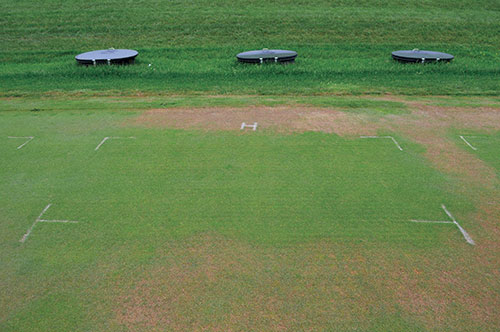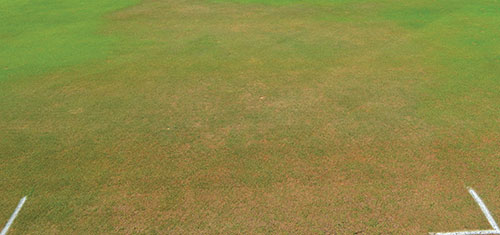Soil surfactant improves performance of greens under stress
Creeping bentgrass (Agrostis stolonifera) and annual bluegrass (Poa annua) are important putting green turfgrass species that are sensitive to drought and traffic stress. The objective of this study was to investigate whether a soil surfactant, Revolution, would positively impact drought and traffic tolerance in grass species on a putting green built to USGA recommendations.
Revolution was applied as a foliar spray at 6 fl. oz./1,000 sq. ft. to creeping bentgrass Penn-A4 and annual bluegrass under three target soil-moisture percentages (8 percent, 12 percent and 16 percent) based on the Rainbird TSM-1 soil sensors in a two-year field study. Golf course traffic was applied through the use of a Mayes traffic simulator to represent low (5,688 rounds of golf), moderate (11,376 rounds) and no traffic (control) that could occur on a golf course putting green in one season.
The effect of Revolution on turfgrass quality, normalized difference vegetation index, soil moisture and percent localized dry spot coverage was measured. Revolution-treated turf that received the least amount of irrigation (8 percent) held more moisture than control plots (plots not treated with Revolution). The high irrigation (16 percent) Revolution-treated plots held less moisture than control plots. Plots treated with Revolution also maintained better quality than control plots. The results of the study show that Revolution can increase turfgrass quality, increase normalized difference vegetation index, decrease localized dry spot by increasing soil moisture when water is insufficient and decrease soil moisture when water is excessive.
Kevin Laskowski, M.S. candidate, Kevin Frank, Ph.D., and Emily Merewitz, Ph.D. are at Michigan State University. Kevin Laskowski can be reached at laskow29@msu.edu for more information.
Photos courtesy of Kevin Laskowski










